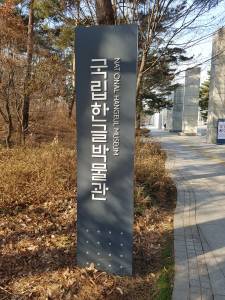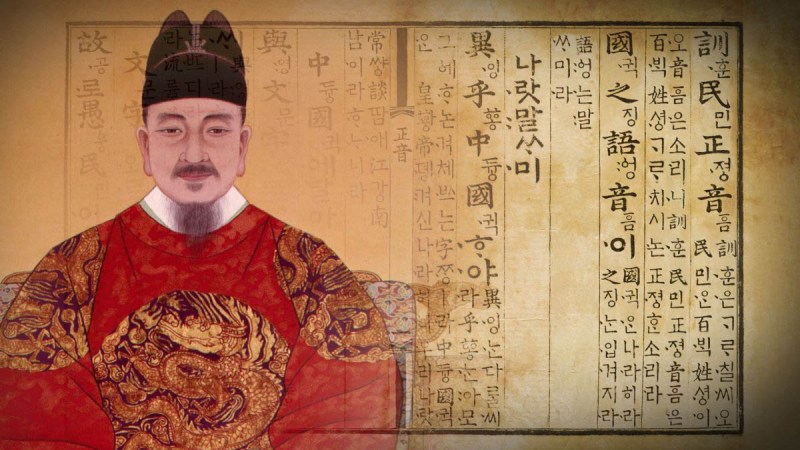Every Korean schoolboy or -girl, every taxi driver, every computer programmer, everybody from the highest to the lowest levels of this society knows the glorious tale of how King Sejong took it upon himself in 1443 to construct an entirely new alphabet to fit the Korean language, freeing the people—the literate ones, at least—from their long dependence on classical Chinese. Hangeul is a fundamental part of Korean culture and a source of enduring pride. For good reason, we celebrate its creation and proclamation here every October 9.
Linguistic specialists like Werner Sasse of Germany, Gari Ledyard of the USA, Hiroyuki Umeda of Japan and Geoffrey Sampson of the UK consider Hangeul the world’s best phonemic writing system. According to the latter, “it’s one of the great intellectual achievements of mankind.”
I wonder how Sejong, who had come to the throne in 1418, did it. The king must have had his hands full in administering the government, but he was a polymath, smart and exceptionally well educated. While he may have had some help from the Jiphyeonjeon or Hall of Worthies, Sejong seems to have produced this featural alphabet in morpho-syllabic blocks on his own. The Worthies, headed by Jeong In-ji, were responsible for compiling the Hunminjeongeum haerye, which clarified how Hangeul could be applied, as well as Yongbieocheonga (“Songs of the Dragons Flying to Heaven”), the first book written in the new script.
responsible for compiling the Hunminjeongeum haerye, which clarified how Hangeul could be applied, as well as Yongbieocheonga (“Songs of the Dragons Flying to Heaven”), the first book written in the new script.
But is it possible that Sejong, the bringer of cultural and political enlightenment to Korea, had a template of sorts? I draw your attention to Drogon Chogyal Phagpa, a 13th century Tibetan scholar and political adviser to Kublai Khan. That Mongol ruler asked him to come up with a new writing system that would unify multilingual Yuan China. So he did, modifying the Tibetan alphabet to create what is known as Phags-pa script. Completed in 1269, it had problems and fell out of use after less than a century.
Nevertheless, some books were written in Phags-pa, a few of which ended up in the Worthies’ library in Seoul! I read in the footnotes of James Scarth Gale’s History of the Korean People, “It is certain that Sejong and his scholars referred to this Phags-pa script when they were devising the Korean alphabet.”
Here Gale—or more precisely, his editor, Richard Rutt—put forth an unambiguous statement, not a theory or supposition, and it is one that some contemporary Koreans might find unwelcome. Eager to know more, I visited the National Hangeul Museum in November but did not see anything about Phags-pa or some Mongolian antecedent. The web site of the National Academy of Korean Language also said nothing of it. I located an authoritative booklet by the Korea Foundation called Hangeul / Korea’s Unique Alphabet, but the story was the same—nothing about Phags-pa.
It is hard not to conclude that Sejong derived five core consonant letters—namely, giyeok, digeut, bieup, chieut and rieul from Phags-pa, because they have more than a passing resemblance to their Mongolian counterparts. I do not assert that Korea’s greatest king borrowed or plagiarized. Sejong’s lofty reputation is such that I might have to lay low for a few weeks if I made such a claim. It certainly appears that some aspects of Hangeul can be traced to Drogon Chogyal Phagpa.
Lorenzo Hervas (1735-1809) of Spain, Joseph Hager (1757-1819) of Italy, Jean-Pierre Abel Remusat (1788-1832) of France and Karl Gutzlaff (1803-1851) of Germany studied Hangeul, followed by Gale whose above-referenced book was published in the late 1920s. (Gale, by the way, co-founded the Royal Asiatic Society-Korea Branch which meets monthly at the Somerset Hotel.) Rutt is fairly clear about the connection between the two purpose-built Asian alphabets. And perhaps no contemporary academic has delved into the subject more fully than Gari Ledyard who bears the imposing title of King Sejong Professor Emeritus of Korean Studies at Columbia University.
Why did later Joseon rulers downplay or worse yet, conceal, Hangeul’s Mongolian roots? Keep in mind that adoption of the Korean alphabet was slow and gradual; not until late in the 19th century did it come into widespread use. Just 125 years ago, it did not have the great reputation it is now accorded. The issue might be traced to the Mongol invasions of Korea, of which there were no fewer than seven between 1231 and 1257. These campaigns were terribly destructive, with thousands of men killed, women raped and people forced into slavery. The Mongols, perceived as barbarians on horseback, burned and pillaged with ferocity. They destroyed, among other things, the magnificent nine-story pagoda known as Hwangnyongsa in Gyeongju and the original version of the Tripitaka Koreana.
After the Mongols were pushed out of Korea in the 1350s, few people remembered them fondly. So it is altogether unsurprising that the influence of Phags-pa on Hangeul has been minimized.


Add Comment